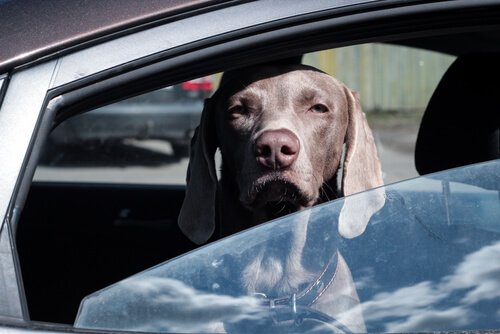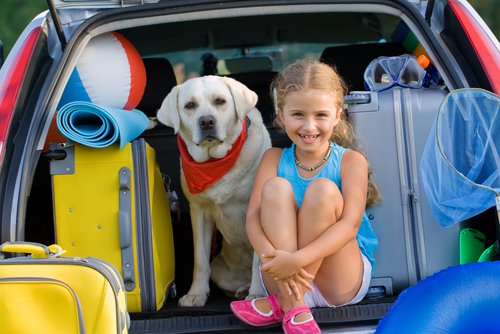Does Your Dog Get Carsick? Here's How to Prevent it!
3 minutes


Written and verified by the lawyer Francisco María García
Last update: 27 December, 2022
A dog sticking his head out a car window with his tongue hanging out is a classic scene. Nowadays, it’s normal for people to take their dogs everywhere, which is often done by car. However, what should you do if your dog gets carsick?
In order to prevent motion sickness, all you have to do is follow some tips, such as playing a game, petting, or giving them a doggy treat. This doesn’t happen with all dogs, but with some it does. It happens more frequently with puppies, and usually stops happening as the dog matures.
It’s important to know why a dog gets carsick. They are just like humans, it’s because the motion affects their sense of balance due to the inner ear fluid. The car’s movements moves the liquid around and it affects certain areas of the brain, where dizziness takes place.
Also, psychological factors are very important. Anxiety and stress can cause a dog to get dizzy in a car or air plane. Excitement or fright can trigger the areas of the brain that are linked to dizziness. If it’s the first time the dog gets in the car, or if it had a negative experience before, it’s likely going to get carsick.
Signs that your dog is carsick
- Visibly drooling more than usual.
- Restlessness and unusual attitudes
- Mildly moaning and complaining.
- Frequent yawning
- Staying still.
- Tries to get out of the car and gets nervous.
- Urinates or defecates.
- Shaking.
- Constant barking.
- Vomiting.

What to do if your dog gets carsick
- Help your dog react positively when he gets into the car, to the point he gets used to it as a puppy. Put him in the car while it’s off, and let him smell it and examine it. He’ll get familiar with it and won’t be so anxious.
-
Avoid giving him a lot of food before a ride. A full stomach can make him vomit, so feed him 2 hours prior to the trip.
-
One of the things that frightens puppies and causes dizziness is the noise the vehicle makes. It’s important to help your dog get used to the sound of the motor.
-
Gradually increase the duration of the rides. You should start with short rides that last for just a few minutes, and gradually increase the time.
-
Bring his favorite toys or blanket, to have him feel calm during the ride. By helping him get familiar with the space is important for making him feel comfortable and confident.
Temperature control and stops
- Make sure the inside environment of the car is at a pleasant temperature to make your dog feel more comfortable. Dogs love open windows, but too much heat can bother them.
- It may be useful to take a short walk with the dog before going for a car ride. That way he can release energy and go to the bathroom if he needs to.

- Get rid of strong odors inside the vehicle, such as air fresheners or perfumes that may affect the dog. Remember, his olfactory system is much more sensitive than ours. A strong smell can be terrible if your dog gets dizzy in the car.
-
If the drive is long, it’s good to plan stops. That way the dog can walk a bit, do his business, and take a drink.
-
It’s always advisable to use a harness or a special dog seat belt to prevent any sudden movements or falls.
If none of these recommendations seem to work, you should talk to your veterinarian. There are medications, such as sedatives and antiemetics, that may be useful in some cases. There are also certain sprays and pheromone treatments to help the dog in these situations.
These tips are a great help if your dog gets carsick while you are on vacation. It’s also important not to neglect your pet once you reach your destination, because the end of the experience should be positive for him, in order to make sure he will always associate car rides with something positive.
A dog sticking his head out a car window with his tongue hanging out is a classic scene. Nowadays, it’s normal for people to take their dogs everywhere, which is often done by car. However, what should you do if your dog gets carsick?
In order to prevent motion sickness, all you have to do is follow some tips, such as playing a game, petting, or giving them a doggy treat. This doesn’t happen with all dogs, but with some it does. It happens more frequently with puppies, and usually stops happening as the dog matures.
It’s important to know why a dog gets carsick. They are just like humans, it’s because the motion affects their sense of balance due to the inner ear fluid. The car’s movements moves the liquid around and it affects certain areas of the brain, where dizziness takes place.
Also, psychological factors are very important. Anxiety and stress can cause a dog to get dizzy in a car or air plane. Excitement or fright can trigger the areas of the brain that are linked to dizziness. If it’s the first time the dog gets in the car, or if it had a negative experience before, it’s likely going to get carsick.
Signs that your dog is carsick
- Visibly drooling more than usual.
- Restlessness and unusual attitudes
- Mildly moaning and complaining.
- Frequent yawning
- Staying still.
- Tries to get out of the car and gets nervous.
- Urinates or defecates.
- Shaking.
- Constant barking.
- Vomiting.

What to do if your dog gets carsick
- Help your dog react positively when he gets into the car, to the point he gets used to it as a puppy. Put him in the car while it’s off, and let him smell it and examine it. He’ll get familiar with it and won’t be so anxious.
-
Avoid giving him a lot of food before a ride. A full stomach can make him vomit, so feed him 2 hours prior to the trip.
-
One of the things that frightens puppies and causes dizziness is the noise the vehicle makes. It’s important to help your dog get used to the sound of the motor.
-
Gradually increase the duration of the rides. You should start with short rides that last for just a few minutes, and gradually increase the time.
-
Bring his favorite toys or blanket, to have him feel calm during the ride. By helping him get familiar with the space is important for making him feel comfortable and confident.
Temperature control and stops
- Make sure the inside environment of the car is at a pleasant temperature to make your dog feel more comfortable. Dogs love open windows, but too much heat can bother them.
- It may be useful to take a short walk with the dog before going for a car ride. That way he can release energy and go to the bathroom if he needs to.

- Get rid of strong odors inside the vehicle, such as air fresheners or perfumes that may affect the dog. Remember, his olfactory system is much more sensitive than ours. A strong smell can be terrible if your dog gets dizzy in the car.
-
If the drive is long, it’s good to plan stops. That way the dog can walk a bit, do his business, and take a drink.
-
It’s always advisable to use a harness or a special dog seat belt to prevent any sudden movements or falls.
If none of these recommendations seem to work, you should talk to your veterinarian. There are medications, such as sedatives and antiemetics, that may be useful in some cases. There are also certain sprays and pheromone treatments to help the dog in these situations.
These tips are a great help if your dog gets carsick while you are on vacation. It’s also important not to neglect your pet once you reach your destination, because the end of the experience should be positive for him, in order to make sure he will always associate car rides with something positive.
This text is provided for informational purposes only and does not replace consultation with a professional. If in doubt, consult your specialist.







